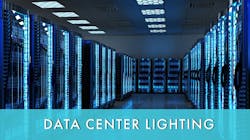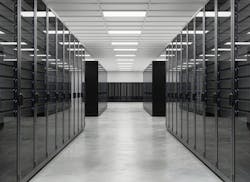According to the International Energy Agency (IEA), data centers account for approximately 1–1.5% of all electricity consumption worldwide. Now that might seem like a small percentage of overall electricity use, but consider that the number of internet users has more than doubled in the years since 2010. IEA says that in order for the Net Zero Scenario to be achieved, “emissions [from data centers and networks] must drop by half by 2030.”
With the increase in remote working, streaming entertainment, gaming, augmented/virtual reality, machine learning, artificial intelligence, and blockchain services, in all likelihood, data centers will need to further increase their efficiency to offset the energy demands of all that data management activity. While renewable energy sources and localized microgrids could make considerable inroads into managing energy consumption over time, data center facilities engineers and owners could consider LED lighting retrofits as a more immediate strategy to boost their energy efficiency.
It has long been established that LEDs deliver additional benefits beyond their low energy consumption, such as reduced heat output and low-voltage capability that can be driven with lower power losses when properly designed. Both of these qualities are key in facilities like data centers, which contain massive amounts of hardware that gives off its own heat and requires additional facility cooling strategies.
In a podcast for Endeavor Business Media’s Data Center Frontier, Lantana LED CEO Sam Rabinowitz spoke with editor-in-chief Matt Vincent about the luminaire designs and approaches to data center needs that the company has evolved over the years since it began working with hyperscalers — high-data-capacity customers that can consume more than 50 MW annually. Here are the top takeaways from their conversation.
“Unintentional” design consequences can open up new market opportunities.
Rabinowitz said the high heat resistance that was designed into his company’s original LED linear luminaire — then marketed under the company name “Project Frog Inc.” and intended for educational environments — enabled Lantana LED to penetrate the data-center sector where a hyperscaler customer was attempting to address its enormous energy consumption across a number of fronts — including lighting. Its facilities needed low-wattage fixtures that could handle the workload and the operating environment. New construction is opening up across the southern United States, said Rabinowitz, and facilities that were built and equipped to the state-of-the-art years back are now entering a cycle of renovation. Thus a new opportunity to develop additional robust LED products was born, resulting in the current Lantana portfolio of 12 luminaires and a remote driver unit offering.
Labor shortages and costs could be addressed with products that are simpler — and safer — to install.
Distributed low-voltage power is part of the secret sauce in serving the data center, said Rabinowitz. DLVP allows distribution of power through smaller transformers located closer to the individual loads and use of Class 2 wiring rather than running longer, high-voltage wiring throughout the building to every powered device. “[Our] LED fixtures run on less than 48V from the remote driver unit to the fixture,” Rabinowitz explained. “This system is a lot faster to install, but it’s also a lot safer and uses less heavy-electrician labor” — meaning less reliance on master electricians who tend to charge higher prices for their work. That’s not to say low-voltage technicians are unskilled, by any means; but their per-hour rate is generally lower and more accessible on large-scale projects that can extend to multiple facilities or campuses, Rabinowitz said.
With LEDs, design for future demands, as well as extremes.
Data center customers want to minimize their maintenance and reduce energy demands for their facilities, just like building owners involved in other applications. However, the long lifetime of LEDs means making a careful selection when you could be committing to a 10-year or longer operational life, countered Rabinowitz. “There are specific, unique operating requirements within data centers. [We decided to] provide fixtures that are UL certified for elevated ambient operating temperatures — and these can be as high as 70°C [158°F] for our products,” he explained.
Why is this heat factor so important? Many customers are building out data centers in areas with harsh climate conditions, such as Arizona and Texas, Rabinowitz said. These climate conditions can fluctuate significantly especially in desert environments. Prolonged, higher-than-normal external temperatures affected the interior aisle temperatures with one customer’s original fixtures, causing them to fail earlier than expected. Furthermore, he noted, today’s servers are running even harder and longer to manage new workloads from generative AI demand or expansion of faster networked services in high-traffic areas. LED luminaires that reduce wasted energy as heat in the conversion from AC to DC power and feature robust thermal management strategies provide greater flexibility for application in the data center.
Who would have thought: Color fidelity matters in a networking facility.
Although the lighting community has certainly accepted the premise that light quality includes color rendering and color fidelity in applications such as retail, museums, galleries, and event venues, perhaps this issue has not been so prominently considered in data center facilities. Operators and technicians need to distinguish between different colored cables and components, Rabinowitz said, and consistent illumination with a higher color rendering index will help them with those fine distinctions. “It’s a simple mistake to see a gray cord versus a lighter, bluish cord that looks a little light gray. And if there isn’t a high enough CRI, it’s very difficult to differentiate between those two colors,” he explained.
Ultimately, Rabinowitz acknowledged that every component that goes into a data center is important for a “micro to macro approach” to cost and efficiency management. Any infrastructure improvement that saves money — including lighting — can enable the operator to invest in other critical building systems and additional hardware capacity.
Written by Carrie Meadows; source material from “The Data Center Frontier Show: Hyperscale LED Lighting Approach A Pathfinder for All Data Centers” used with permission. Listen to the full podcast on datacenterfrontier.com.
CARRIE MEADOWS is editor-in-chief of LEDs Magazine, with 20-plus years’ experience in business-to-business publishing across technology markets including solid-state technology manufacturing, fiberoptic communications, machine vision, lasers and photonics, and LEDs and lighting.
Follow our LinkedIn page for our latest news updates, contributed articles, and commentary, and our Facebook page for events announcements and more. You can also find us on the X platform.






